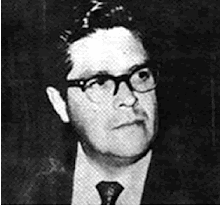
Guillermo Gonzalez Camarena
Honor Earth’s mightiest inventors and discoverers, Albert Einstein, Leonardo Da Vinci, Aristotle, Galileo Galilei, Thomas Edison, and Guillermo Gonzalez? Yes, he is in the list of the “forgotten inventors” by the world. Most of the other scientists were rich and their countries were well developed, but Gonzalez didn’t have that; he aqui su vida… (Here is his life)...
Guillermo Gonzalez Camarena was born on February 17, 1917 in Guadalajara, Jalisco, Mexico and at 2 years old, his family moved to Mexico City to have a better life. At an early age, he began to show interest in electronics by making electrically propelled toys and instruments. Soon, his basement became his laboratory, and there, at 12 years of age he created his first amateur radio. He then studied at the School of Mechanical and Electrical Engineers (ESIME) at the IPN (Instituto Politécnico Nacional, in English, National Polytechnic Institute) in 1930 and two years later he received his license to work as an operator at a radio station in Mexico’s Department of Public Education.
He invented his own TV in 1934 at the age of 17 from scrap materials from local flea markets. With the goal of giving color television to Mexico, he developed and patented a Trichromatic Sequential Fields System from primary colors, a device that could be used to adapt to the black and white television systems. This last patent was granted to him when he was 23 years of age and, On August 31, 1946, González Camarena sent his first color transmission from his lab in the offices of The Mexican League of Radio Experiments in Mexico City. In 1948, he established Gon-Com laboratories to manufacture TV transmission equipment and in that year, he invented the first remote control in Mexico.
With his potential, Columbia College of Chicago requested he design a system, so the young Mexican researcher exported televisions produced in Mexico. On January 1951, the company Radio Panamericana hired him to install the first transmitter station of Mexican television, which was placed between the volcanoes Popocatepetl and Iztaccihuatl (near Mexico City). Being of humble origins, Camarena worried his invention may be out of reach for people of scarce resources, so he presented a cheaper but better invention, the Simplified Bicolor System in 1963. His newest invention was well received internationally and solved the economic aspect for future buyers. Not only in Mexico it was a hit, but in other nations as well. A very similar invention was used during the NASA’s Voyager mission in 1979, to take pictures and videos of Jupiter. Even though the US had their NTSC (a type of analog television system), it was too complex to use in a far away distance and instead used Gonzalez’s simpler system.Unfortunately, on April 18, 1965, when returning from inspecting the transmission station of Channel 5 in Las Lajas, Veracruz he met death. He suffered an automobile accident that caused his death in Puebla, he was 48 years old.
Besides being an inventor, Gonzalez Camarena liked astronomy, and created his own telescope that included him in the Astronomical Society of Mexico, also was interested in archeology and Mexican history, played several musical instruments and composed several songs. In addition, he believed that television should be used to educate, so in coordination with the Ministry of Public Education he projected what would be known as “Sistema de Educación Telesecundaria”*. In 1995, a Mexican science research and technology group created “La Fundación Guillermo González Camarena” (“The Guillermo González Camarena Foundation”), which benefits creative and talented inventors in Mexico. This honors the creativity of the distinguished scientist who developed one of the inventions with greatest world repercussion: color television.
This brilliant Latin inventor devoted himself to the good of his country and people, Mexico. He managed to accomplish what other people with more advantages could not. He made a huge impact in Mexican history, communication, and education by introducing color TV and new technologies to Mexico. He inspired many people that they could accomplish what they put in mind. He truly represents an example of Mexican spirit.
*- In Mexico there are three types of middle schools, and in telesecundarias I think you take notes from TVs.


